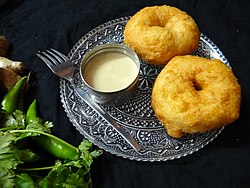Medu vada
Deep-fried Indian food item From Wikipedia, the free encyclopedia
Medu vada (pronounced [meːd̪ʊ vəɽaː]; lit. 'soft vada' in Tamil and Kannada) is a South Indian breakfast snack made from Vigna mungo (black lentil). It is usually made in a doughnut shape, with a crispy exterior and soft interior.[1] A popular food item in South Indian cuisine[2] it is generally eaten as a breakfast or a snack.[1][3]
 | |
| Alternative names | Garelu, Uddina vade, Medhu vada, Uddi vada, Minapa garelu, Uzhunnu vada, Udid Vada, Ulundu vadai, Urad vada, Ulundu wade, Urdi bara, Batuk |
|---|---|
| Type | Fritter |
| Course | Breakfast |
| Place of origin | India |
| Region or state | South India, Sri Lanka |
| Serving temperature | Warm (with sambar and coconut chutney) or room temperature (with yogurt) |
| Main ingredients | Urad dal (Split Black gram), Rice |
| Similar dishes | Other vadas, mat pe kyaw |
Etymology
"Medu" (ಮೆದು) means "soft" in Kannada, thus "medu vada" means "soft vada".[1][4] The dish is often mentioned simply as "vade" on menus.[5] Other names for the dish include uddina vade Kannada, urad vada, medhu vadai, ulundu vadai (Tamil), garelu(గారెలు) (Telugu), uzhunnu vada (Malayalam),[6][7] batuk (Nepali),[8] and ulundu vadai (Sinhala).
History
According to Vir Sanghvi, the origin of medu vada can be traced with "some certainty" to the Maddur town in present-day Karnataka. The dish was made popular outside South India by Udupi restaurateurs of Mumbai.[5]
Preparation
The medu vada is made primarily of black lentils (urad dal) batter.[1] The black lentils are soaked in water for several hours, and then ground to a paste.[1] The paste may be flavoured with other ingredients such as asafoetida, methi seeds (fenugreek), ginger, cumin seeds, black pepper, curry leaves, chillies and coconut pieces.[1] It is then patted into doughnut-shapes and fried in oil until golden brown.[1][2]
One variation involves baking instead of frying.[1] Other variations of the dish involve use of pulses other than black lentils. For example, am-bada (or aama vadai) is made with chana dal (split chickpea lentil); occasionally, tuar (pigeon pea) and masoor (lentil) are also used.[9]
Serving
The dish is usually served with sambar (lentil and vegetable stew) and coconut chutney. Along with idli, it is often eaten as a breakfast dish. It is also eaten as a lunch starter or a snack.[2][10]
The medu vada is sometimes also served with yogurt, as a chaat snack (see dahi vada).[1]
In Nepal, on the day of Maghe Sankranti, people make batuk, which is eaten with a variety of boiled tubers such as yam, taro, and sweet potato.[11]
Gallery
See also
References
External links
Wikiwand - on
Seamless Wikipedia browsing. On steroids.





